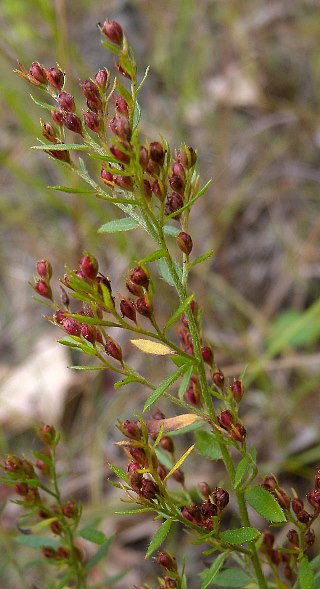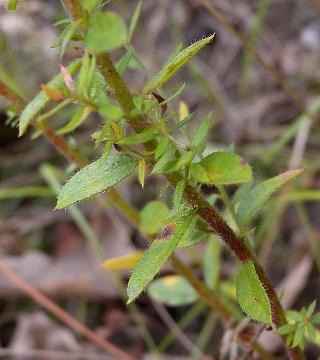Description:
This perennial plant is ½–1½' tall and abundantly branched,
particularly along the upper two-thirds of its length. The pale green
stems are sparsely to moderately covered with white hairs that are
upwardly appressed or ascending. Small leaves about 8-15 mm. (1/3–2/3")
long and about one-third as much across occur along the stems: they are
alternate, opposite, or whorled. The leaf blades are green (turning
yellow during the fall), smooth and ciliate along their margins, and
elliptic-oblong with blunt tips; the base of each leaf blade is
sessile, or it is has a
short petiole. The upper surfaces of the blades are hairless to
sparsely hairy, while the lower surfaces of the blades are usually
hairy, particularly along the midveins. Similar to the hairs on the
stems, the hairs on the leaves are appressed or curve outward toward
their tips. The middle to upper stems produce overlapping panicles of
flowers. Individual panicles are longer than they are wide, and they
produce leafy bracts that are similar to the leaves, except the former
are smaller in size. The small flowers are borne individually on the
secondary and tertiary branches of the panicles. Each flower is about 2
mm. long and a little less across, consisting of 5 persistent purplish
red petals, 5 ascending green sepals (sometimes becoming red later), 3
or more stamens, and a 3-celled ovary with short stigmata at its apex
(there are no filaments). Each flower has a short slender pedicel about
1 mm. long. The blooming period occurs during the late summer for about
a month; only a few flowers are in bloom at the same time. The flowers
are probably cross-pollinated by wind, at least in part. Each flower is
replaced by an ovoid seed capsule about 2 mm. long that typically
contains 2-3 seeds; because of the persistent petals and sepals, it is
purplish red or greenish red in appearance. The 2 outer sepals are the
same length or longer than the seed capsule (2 mm. in length or more)
and they are linear in shape. The 3 inner sepals are shorter than the
seed capsule (less than 2 mm. in length) and they are ovate in shape.
After the seed capsules open, the small seeds are dispersed primarily
by gravity and usually fall only a short distance from the mother
plant. During the late fall, the flowering plant withers away and it is
replaced by a low rosette of little-branched stems with whorled or
opposite leaves; this rosette spans about 3-4" across and usually
survives the winter until it is replaced by a flowering plant during
the next spring. The basal leaves are similar to the cauline leaves of
the flowering plant, except they are more wide in shape (oval-ovate).
The root system consists of a slender taproot with fibrous secondary
roots; sometimes the taproot is barely distinguishable from these
secondary roots.
opposite, or whorled. The leaf blades are green (turning
yellow during the fall), smooth and ciliate along their margins, and
elliptic-oblong with blunt tips; the base of each leaf blade is
sessile, or it is has a
short petiole. The upper surfaces of the blades are hairless to
sparsely hairy, while the lower surfaces of the blades are usually
hairy, particularly along the midveins. Similar to the hairs on the
stems, the hairs on the leaves are appressed or curve outward toward
their tips. The middle to upper stems produce overlapping panicles of
flowers. Individual panicles are longer than they are wide, and they
produce leafy bracts that are similar to the leaves, except the former
are smaller in size. The small flowers are borne individually on the
secondary and tertiary branches of the panicles. Each flower is about 2
mm. long and a little less across, consisting of 5 persistent purplish
red petals, 5 ascending green sepals (sometimes becoming red later), 3
or more stamens, and a 3-celled ovary with short stigmata at its apex
(there are no filaments). Each flower has a short slender pedicel about
1 mm. long. The blooming period occurs during the late summer for about
a month; only a few flowers are in bloom at the same time. The flowers
are probably cross-pollinated by wind, at least in part. Each flower is
replaced by an ovoid seed capsule about 2 mm. long that typically
contains 2-3 seeds; because of the persistent petals and sepals, it is
purplish red or greenish red in appearance. The 2 outer sepals are the
same length or longer than the seed capsule (2 mm. in length or more)
and they are linear in shape. The 3 inner sepals are shorter than the
seed capsule (less than 2 mm. in length) and they are ovate in shape.
After the seed capsules open, the small seeds are dispersed primarily
by gravity and usually fall only a short distance from the mother
plant. During the late fall, the flowering plant withers away and it is
replaced by a low rosette of little-branched stems with whorled or
opposite leaves; this rosette spans about 3-4" across and usually
survives the winter until it is replaced by a flowering plant during
the next spring. The basal leaves are similar to the cauline leaves of
the flowering plant, except they are more wide in shape (oval-ovate).
The root system consists of a slender taproot with fibrous secondary
roots; sometimes the taproot is barely distinguishable from these
secondary roots.
Cultivation:
The preference is full or partial sun, moist to dry conditions, and
either sandy or very rocky soil. The seeds are slow to germinate, often
remaining dormant for several years.
Range & Habitat:
The native Small Pinweed is an uncommon plant that is found in NE
Illinois and
scattered locations elsewhere in the state (see Distribution
Map). Habitats include sand prairies, openings and edges of
sandy oak woodlands, sandy oak savannas, rocky bluffs and cliffs,
partially wooded sand dunes near Lake Michigan, and edges of sandy
marshes. In many areas, populations of Small Pinweed have declined as a
result of habitat destruction from various development projects. Like
other Lechea spp. (Pinweeds), it is adapted to
occasional disturbance (wildfires, shifting dunes), but dislikes
extreme or more frequent
modifications of its environment.
more frequent
modifications of its environment.
Faunal Associations:
In general, very little is known about the floral-fauna relationships
of Lechea spp. (Pinweeds); they have not been
studied adequately, thus some of the following information is
speculative. The flowers offer no nectar to insect visitors; only
pollen is available as a food reward. It is possible that various
flies, small bees, and other small insects are minor pollinators of the
flowers, which are self-fertile and probably cross-pollinated by the
wind. The larvae of two micromoth species, Mompha capella and Morpha passerella,
bore into the seed capsules of Lechea spp. (Pinweeds); see Microleps
website (accessed 2010). It has been found that White-tailed Deer
preferentially browse on Lechea maritima (Beach Pinweed) in Virginia (see
Keiper, 1990), and thus they may browse on other Pinweeds in other
areas as well.
Photographic Location:
Edge of a sandy oak woodland that is located near a wet sand prairie at
the Iroquois County Conservation Area in Iroquois County, Illinois.
Comments:
In most of Illinois, Lechea spp. (Pinweeds) are
restricted to sandy habitats, although in southern Illinois some
species (including Small Pinweed) can be found along cliffs and upland
woodlands that are rocky. The various species are very similar to each
other in appearance and can be difficult to differentiate. The presence
of mature fruits on a prospective plant greatly facilitates its
identification and, to a lesser extent, the shape of the leaves and
type of hairs on the stems facilitates species identification as well.
Small Pinweed can be distinguished from other similar Pinweed species
as follows: 1) it has wider leaves than some other species, which are
more linear in shape, 2) the hairs on its stems are upwardly appressed
or ascending, rather than widely spreading or absent, 3) the seed
capsules are ovoid in shape, rather than globoid or subgloboid, and 4)
the outer sepals of Small Pinweed are longer than the inner sepals and
they are as long or longer than the seed capsules. The only other
Pinweed in Illinois with the last characteristic is Lechea
tenuifolia (Slender Pinweed), which differs by having linear
leaves and it tends to be smaller in size. Another common name of Lechea
minor is Thyme-Leaved Pinweed.